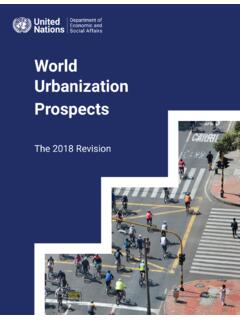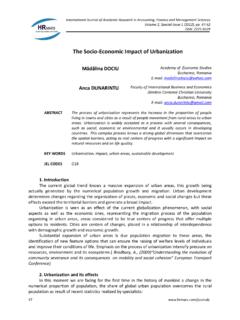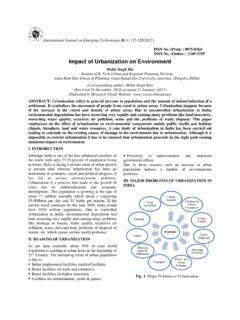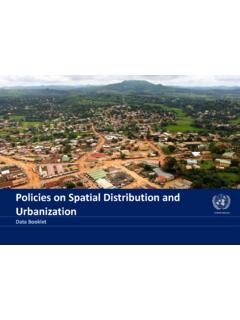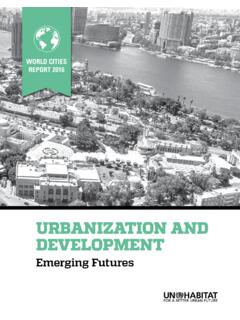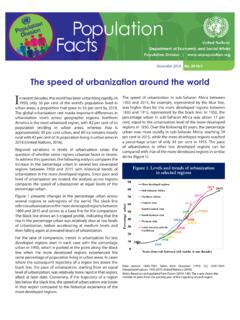Transcription of THE POTATO’S CONTRIBUTION TO POPULATION AND …
1 THE POTATO S CONTRIBUTION TOPOPULATION AND urbanization : EVIDENCE FROMA HISTORICAL EXPERIMENT NATHANNUNN ANDNANCYQIANW eexploit regional variation in suitability for cultivating potatoes , togetherwith time variation arising from their introduction to the Old World from theAmericas, to estimate the impact of potatoes on Old World POPULATION andurbanization. Our results show that the introduction of the potato was re-sponsible for a significant portion of the increase in POPULATION and urbaniza-tion observed during the eighteenth and nineteenth centuries.
2 According to ourmost conservative estimates, the introduction of the potato accounts for approx-imately one-quarter of the growth in Old World POPULATION and urbanizationbetween 1700 and 1900. Additional evidence from within-country comparisonsof city populations and adult heights also confirms the cross-country : J1, N1N5, INTRODUCTIONB etween 1000 and 1900, world POPULATION grew from under300 million to billion, and the share of POPULATION living in ur-ban areas more than quadrupled, increasing from two to over ninepercent.
3 As shown in FigureI, the increase accelerated dramati-cally over time and occurred almost entirely towards the end of theperiod. The determinants of these phenomena have been of muchinterest to economists, demographers, and historians uses country-level historical data on POPULATION and urban-ization toempiricallyinvestigatetheextent towhichthis historical Wethank the editor Larry Katz and five anonymous referees for commentsthat significantly improved the paper. We also thank David Canning, GregoryClark, Angus Deaton, Azim Essaji, Andrew Foster, Oded Galor, Claudia Goldin,Mikhail Golosov, Jonathan Hersh, Wolfgang Keller, Joel Mokyr, AlejandroMolnar, Petra Moser, Jean-Laurent Rosenthal, Yona Rubinstein, Andrei Shleifer,Peter Temin, Hans-Joachim Voth, and David Weil for valuable feedback anddiscussions.
4 We also thank seminar participants at Bocconi University, BostonUniversity, Brown University, Harvard University, MIT, Ohio State Univer-sity, Princeton University, Stanford University, Tufts University, University ofChicago School of Business, BREAD, CEA Annual Meetings, ISNIE Annual Con-ference, NBER SI, and NEUDC Annual Conference. We also thank Sayon Deb forexcellent research For studies in the growth literature that have focused on the link betweenpopulation increase and factors such as per capita incomes, seeGalor and Weil(2000), Jones(2003), andVoigtl ander and Voth(2006).
5 For micro-level studies ofthe determinants of increased life expectancy, see the literature review providedbyCutler, Deaton, and Lleras-Muney(2006).c The Author(s) 2011. Published by Oxford University Press on behalf of President andFellows of Harvard College. All rights reserved. For Permissions, please email: Quarterly Journal of Economics(2011) 126, 593 650. Access publication on June 27, by guest on July 22, from 594 QUARTERLY JOURNAL OF ECONOMICSFIGUREIG rowth in World POPULATION and urbanization , 1000 1900increase is due to the introduction of potatoes from the NewWorld to the Old World, by which we mean the entire provide more calories, vitamins, and nutrients perarea of land sown than other staple crops.
6 The potato s role inincreasing POPULATION and promoting economic development hasbeen a subject of much discussion amongst scholars across a vari-ety of disciplines ( ,Langer 1963; McNeill 1948, 1999; Salaman1949). For example, historian WilliamLanger(1963, p. 14) arguesthat within Europe, the spread of the potato culture everywherecorresponded with the rapid increase of POPULATION . potatoes dra-matically improved agricultural productivity and provided morecalories and nutrients relative to preexisting Old World Wealth of Nations, Adam Smith extols the advantages ofpotatoes over preexisting staples in Europe, writing that the foodproduced by a field of potatoes is.
7 Much superior to what is pro-duced by a field of wheat.. No food can afford a more decisiveproof of its nourishing quality, or of its being peculiarly suitable tothe health of the human constitution (Smith 1776, pp. 67 68).22. Other historians have attributed even greater significance to the (1999, p. 67), in an article titled How the Potato Changed World History, argues that potatoes , by feeding rapidly growing populations, permitted a handfulof European nations to assert domination over most of the world between 1750 and by guest on July 22, from POTATO S CONTRIBUTION TO POPULATION AND URBANIZATION595 Similar observations have been made outside of Europe.
8 A partic-ularly interesting example comes from anthropologist Christophvon F urer-Haimendorf(1964), who argues that the introduction ofthe potato into Nepal significantly increased food production andagricultural surplus. He writes that the POPULATION of Khumbuwas a fraction of its present size until the middle of the nineteenthcentury and there can be no doubt that the great increase of thelast hundred years coincided with the introduction and spreadof the potato (pp. 9 10).3 Another example is from the famousJapanese scholar Takano Ch oei, who wrote of the benefits of thepotato in his 1836 treatiseNi butsu k o.
9 He argued that extensivecultivation of potatoes would cure many social ills of the empireby alleviating food demands from a growing POPULATION (Laufer1938, p. 83).Despite qualitative accounts of the benefits of the potato tothe Old World, empirical evidence quantifying the overall impactof the potatois scarce. This is nodoubt partly due tothe estimationdifficulties caused by the endogeneity of potato adoption. First,there is an issue of reverse causality. The adoption of potatoesmight have caused POPULATION growth, but alternatively, latentpopulation pressure and the associated demand for food mighthave caused the adoption of potatoes .
10 A number of historians haveargued for the latter relationship ( ,Salaman 1949; Connell1962; Cullen 1968). The second problem is joint POPULATION growth and the adoption of new agricultural tech-nologies can be the outcome of a third unobserved best of our knowledge, the only existing empirical studyattempting to estimate the causal effect of potatoes is a study byJoelMokyr(1981), in which he examines the relationship betweenpotato adoption and POPULATION growth across Irish counties in1845. He addresses endogeneity issues by estimating a system oftwo equations using 2 SLS, instrumenting for potato cultivation1950.










